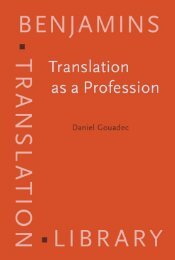Constructing a Sociology of Translation.pdf
Constructing a Sociology of Translation.pdf
Constructing a Sociology of Translation.pdf
- No tags were found...
Create successful ePaper yourself
Turn your PDF publications into a flip-book with our unique Google optimized e-Paper software.
70 Theo Hermanstions are produced over time and representational modes are selected and re-selected,and it is reflected in the programmes fleshing out the schema <strong>of</strong> translation.The programmes are not uniform. Because in the modern world translationcaters for an array <strong>of</strong> differentiated function systems, it is also itself differentiated.Nevertheless the system as a whole remains distinct. It allows itself to be irritatedby different systems in its environment, but its resonance comes from within andis determined by its form.The idea <strong>of</strong> form I am using here has an inside and an outside. It was Michelangelo,I think, who explained that the statue he wanted to carve was alreadythere waiting within the block <strong>of</strong> marble in front <strong>of</strong> him; all he had to do wasliberate it by chipping away the redundant stone. Form is two-sided. The inside iswhat is there; the outside is what had to be cut away for the inside to be revealed.Form is arrived at by selection, that is, by excluding what is not included and thenconcentrating on what is included as the inside <strong>of</strong> the form. The exclusions, fortheir part, are not just “potentialized” as I suggested above, but bracketed in time,temporalized, hence they remain available for future use.What is the point <strong>of</strong> trying to think the form <strong>of</strong> translation along these lines?Just as speaking cuts into silence, what is translated is always pr<strong>of</strong>iled against whatis left untranslated. But silence can also communicate: it may communicate an inabilityor an unwillingness to translate. Moreover, just as, in speaking, the words aspeaker selects push back other words, those that could have been spoken but werenot, a translation <strong>of</strong>fers its particular choice <strong>of</strong> words by obscuring other choices,as we saw before. In doing so, it activates one mode <strong>of</strong> representation at theexpense <strong>of</strong> alternative modes. The temporal sequence in which these differentialchoices are made constructs a past as well as a future. The future is the horizon <strong>of</strong>possibilities that is conditioned by the present but that may still mine the past inunexpected ways. The past may be thought <strong>of</strong> as the storeroom in which selectionsand inclusions are archived, selectively, as part <strong>of</strong> a process <strong>of</strong> forgetting as well asremembering. We deselect outmoded ways <strong>of</strong> translating and let them sink intooblivion so as to retain only a conveniently foreshortened canon <strong>of</strong> successful pastselections as a template for day to day use. But nothing prevents us from occasionallystirring up the sediment and reinstating former rejects, bringing them backfrom the margins. This is, to name just one instance, what Lawrence Venuti did inThe Translator’s Invisibility (1995) when he extracted from the historical archive alargely forgotten genealogy <strong>of</strong> non-fluent translation as a way <strong>of</strong> buying credit forhis own programme <strong>of</strong> “resistant” translation. The past is that selection <strong>of</strong> formsthat the present holds available for future use.In all these ways, it seems to me, considering form as two-sided allows us toappreciate translation as involving ongoing selection and therefore exclusion as
















